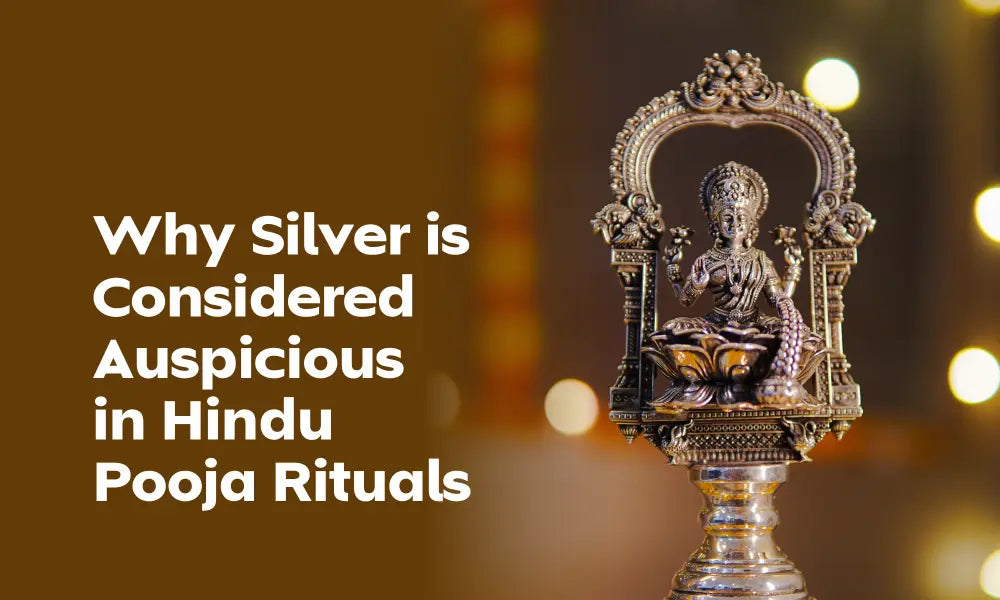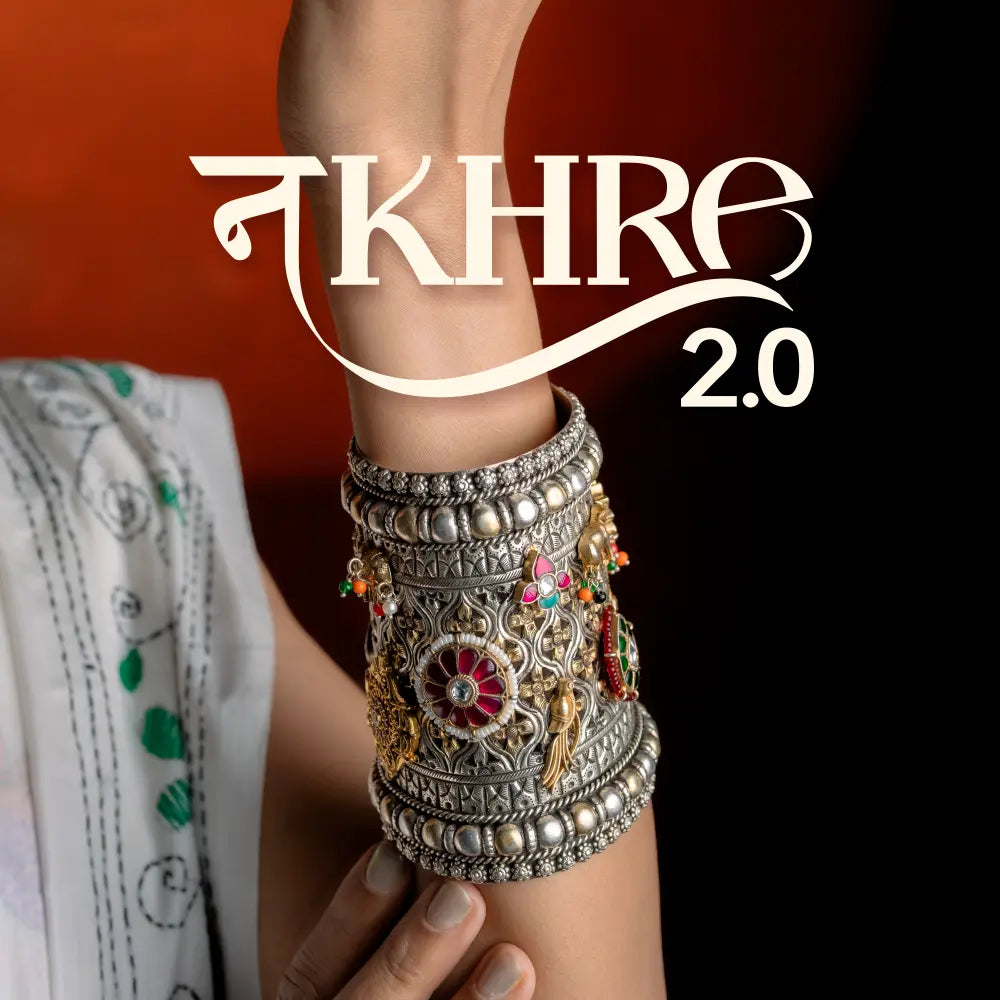
Why Silver Is Considered Auspicious in Hindu Pooja Rituals
Step into any Hindu household during a festival, and you’ll notice a common sight: gleaming silver thalis with kumkum and rice, silver diyas glowing with ghee, or a melodious silver bell ringing during aarti. Silver has been at the heart of Indian spiritual traditions for centuries. Whether it is Diwali, Ganesh Chaturthi, Navratri, or daily puja, silver is considered more than just a metal—it is an auspicious companion of rituals.
But what makes silver so sacred? Why is it chosen above other materials for puja rituals? The answers lie in a fascinating blend of spirituality, science, and tradition.
Historical Roots of Silver in Hindu Rituals
The significance of silver in Indian culture stretches back thousands of years. Ancient scriptures, including the Vedas and Puranas, describe silver as a metal linked with the moon (Chandra), symbolising calmness, purity, and feminine energy.
Kings and temples often used silver for religious offerings. Records show that during the Chola dynasty, elaborate silver lamps and thalis were commissioned for temples, some of which are still in use today. Even today, many Indian temples preserve idols, ornaments, and ritual vessels crafted in silver—proof of its enduring spiritual value.
Silver was also believed to protect against negative energies, making it a preferred material for puja thalis, diyas, and coins offered during rituals.
Spiritual Significance of Silver
In Hindu belief, silver embodies several spiritual qualities that make it auspicious for worship:
- Association with Chandra (Moon): The moon is linked with peace, emotional balance, and cool energy. Silver, as the moon’s metal, reflects these qualities, bringing calmness to the worshipper.
- Purity: Silver’s reflective surface symbolizes the purity of mind and soul needed during puja.
- Prosperity: Goddess Lakshmi, the deity of wealth, is often associated with silver ornaments and coins. Offering or using silver during puja is believed to attract prosperity.
-
Balance: Gold is linked with Surya (sun), and silver with Chandra (moon). Together, they symbolize cosmic balance.
This deep symbolism is why silver items are a constant presence in rituals, from everyday pujas to grand festivals.
Scientific Perspective: The Healing Metal
Beyond spirituality, science provides fascinating reasons why silver became the metal of rituals:
- Antimicrobial Properties: Silver has natural antibacterial qualities. Studies show that silver ions can neutralize harmful microbes, which is why silver utensils are traditionally used to store water, milk, or prasadam during rituals.
- Energy Conductor: In Ayurveda, silver is considered a “cooling” metal, balancing pitta (fire element). Using silver thalis or glasses during rituals is believed to regulate energy flow.
-
Durability: Unlike other metals, silver withstands frequent use, oil, ghee, and soot from diyas without corroding quickly.
Thus, silver wasn’t chosen for rituals only because of belief—it had practical, health-oriented benefits too.
Role of Silver in Hindu Rituals
1. Silver Diyas and Niranjans
Lighting a diya marks the beginning of almost every Hindu ritual. A silver diya represents purity and the victory of light over darkness. Designs like Peacock Niranjan or Elephant Niranjan carry additional symbolism—peacocks for beauty and devotion, elephants for wisdom and strength.
Lighting diyas in silver vessels is considered more auspicious than using clay or brass, as the reflective glow enhances the sacred atmosphere.
2. Silver Thalis
The pooja thali is the foundation of worship. It carries kumkum, haldi, rice, incense, flowers, and prasad. A silver thali amplifies the sanctity of these offerings. Its lustrous surface is said to magnify positive vibrations, making prayers more powerful.
Families often pass down silver thalis as heirlooms, connecting generations through devotion.
3. Silver Samai (Traditional Lamps)
The samai, a tall standing lamp, holds multiple wicks and is a staple in festivals like Navratri and Diwali. Lighting a silver samai during Durga aarti or Lakshmi puja is considered especially auspicious, symbolising endless prosperity.
Unlike small diyas, samais are lit continuously through the night, filling homes with divine energy.
4. Silver Coins and Tokens
Silver coins engraved with Lord Ganesha, Goddess Lakshmi, or Saraswati are commonly offered during pujas. These coins are placed on the altar during rituals and later kept in lockers or puja rooms for blessings of wealth and wisdom.
During Diwali, gifting silver coins is considered a way of passing prosperity and positivity to loved ones.
5. Utensils and Bells
Silver glasses, bowls, and spoons are used to serve milk, ghee, or prasadam, ensuring purity of offerings. A silver bell (ghanti), when rung during aarti, is believed to dispel negativity and invite divine presence with its clear tone.
Festivals and Silver: A Sacred Connection
Silver’s role in Hindu rituals becomes even more significant during major festivals:
- Ganesh Chaturthi: Silver thalis and diyas adorn the altar of Lord Ganesha. Many families also gift silver coins during this festival.
- Navratri & Durga Pooja: Lighting silver samais during Durga aarti is believed to invoke the Goddess’s blessings.
- Diwali: Silver diyas and coins are central to Lakshmi puja, symbolising wealth and purity.
- Karva Chauth & Weddings: Silver thalis are used in rituals of marriage and fasting ceremonies.
-
Naming Ceremonies (Namkaran): Babies are often gifted silver anklets, bowls, or spoons for health and protection.
Each festival adds another layer of meaning to silver’s sacred role.
The Modern Ethno-Spiritual Trend
In today’s times, silver has become the preferred choice for rituals not just because of tradition but also due to practicality:
- Affordability: Compared to gold, silver offers accessible luxury.
- Aesthetics: Modern designs make silver puja items double as décor pieces for homes.
-
Gifting Value: Silver coins, diyas, or thalis make memorable gifts that are meaningful and reusable.
This balance of tradition and modernity has given rise to what can be called ethno-modern spirituality—where families use heritage metals like silver but in contemporary, stylish forms.
The Silvogue Touch
For rituals as sacred as Navratri, Diwali, or Durga Pooja, purity and craftsmanship matter. Silvogue offers hallmarked 925 sterling silver puja essentials that embody both devotion and artistry.
From intricately designed samais to versatile thalis and elegant diyas/niranjans, every piece is crafted to enhance your home temple. Their silver coins and bells add that final touch of tradition, ensuring your rituals are performed with authenticity and grace.
Conclusion
Silver has stood the test of time—not just as jewellery, but as a sacred part of Hindu worship. Its reflective brilliance, cultural symbolism, and scientific benefits make it more than a metal; it is a bridge between faith and function.
From the diya you light at dawn to the thali you hold during evening aarti, silver elevates every ritual, turning it into an act of beauty and devotion. Festivals like Diwali, Navratri, and Ganesh Chaturthi shine brighter when silver graces the altar.
This year, let silver be more than a tradition—let it be your companion in devotion. Explore Silvogue’s range of silver pooja essentials and bring home the auspicious glow that has guided Hindu households for centuries.
Because in every flame reflected on a silver diya, in every offering made on a silver thali, lies a timeless truth: silver doesn’t just shine—it sanctifies.



